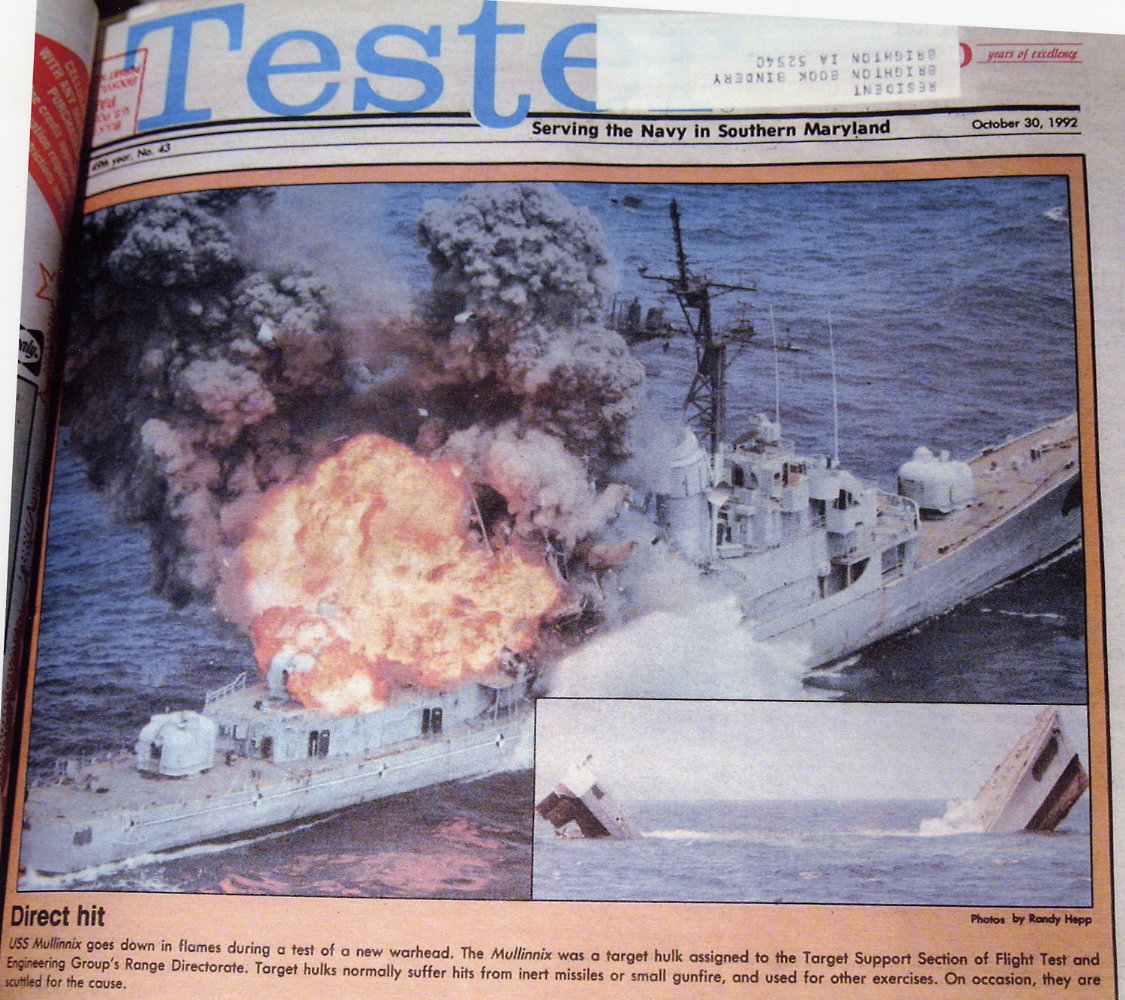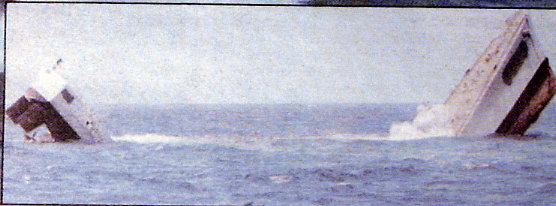USS MULLINNIX DD-944
SINKEX TESTER ARTICLE
The following information appeared in TESTER on October 30, 1992

Target Support Section hits the mark
By John Romer
Public Affairs Office
The caption under the Mullinnix 'explosion' picture read "DIRECT HIT - USS Mullinnix goes down in flames during a test of a new warhead. The Mullinnix was a target hulk assigned to the Target Support Section of Flight Test and Engineering Group's Range Directorate. Target hulks normally suffer hits from inert missiles or small gunfire, and used for other exercises. On occasion they are scuttled for the course."
A small section of the Flight Test and Engineering Group at Pax River has the distinction of operating the Navy's only target that represents the sea-skimming, supersonic cruise missile threat to ships. The Target Support Section, attached to the Chesapeake Test Range, operates the Vandal missile launch site located on NASA-owned Wallops Island, Va.
Mike Johnston, who heads the Target Support Section, said his activity became involved in the target missile program as research development test and evaluation and fleet training requirements changed during the early 1980s. Then, the section, which employed about eight, maintained and was responsbile for the Hooper and Hannibal targets in the Chesapeake Bay.
One thing that really sets us apart from other target support activities throughout the Navy, Johnston said, is that the Patuxent River-based unit does "full-scale hulk work." When it comes to target hulks, Johnston's crew runs the gambit, from acquisition of the ship; to getting it environmentally prepared; to outfitting it for the tests or fleet exercises.
Today, about 50 federal and Dyncorp contract employees in the section maintain and operate a small fleet of five target hulk ships, three of them full-size; three radio-controlled target boats, one five-engine, gasoline powered, 56-footer; several patrol and utility boats, a 100-foot Navy crew boat; and a jack up barge, used for project work requireing a stable platform at sea. But it doesn't stop there. The Target Support Section, which falls under the Range Directorate, a former East German coastal patrol boat capable of firing Styx missiles. That ship, now in dry dock, will participate in future fleet exercises...
(I've left out the part on the manufacture of land targets and air targets.)
...Plastic targets, however, cannot be used to test or evaluate radar systems' abilities to detect the targets, "threats," as Johnston calls them...
Johnston added providing target hulks for fleet support is a large portion of the section's reason for being. "Normally, we support one fleet exercise per quarter," the Range Directorate section head told the Tester.
The target hulks, Johnston explained, are decommissioned, stripped ships. But when they are prepared as targets, they represent real radar threats for the fleet ships and aircraft. Basically, the target hulks aare equipped with emitters to stimulate the seeker of the Harm missiles. The hulk targets are instrumented to simulate a search radar which the Harm missile can identify, classify and then lock on to. Harm missile training exercises, Johnston said, need simulated radar, which is classified as the treat. That's what the target section is all about, he noted.
But, Johnston was quick to point out, it's not just a matter of towing these hulks to the target area and letting the fleet shoot at them. It takes four to six months to prepare a target hulk ship for an exercise, Johnston explained.
Before they can be used, they are made environmentally safe. All lubricants, oils, and fuels are pumped from the ship and all tanks drained. Then they are highly instrumented, depending on the exercise. Even before it is towed to the target area, the section must make certain a hulk meets towning requirements - to include navigation lights and automatic flood indicators - to alert the towing tug crew should it begin to take on water.
Basically, Johnston said, the hulk is a support platform fitted with instruments. This may include radars and high-speed cameras to record the missile impacts and chaff launchers. Shock-mounted diesel generators are installed to provide power for the equipment.
"Everything is remotely controlled from the FTEG's airborne platform the Convair 880," Johnston said. The target support chief said the equipment and instrumentation “are tailored to the customer’s needs.”
Several hours before a fleet exercise or a test, Johnston said, a crew from the target section boards the hulk to make sur4e all systems are go. The crew departs and returns after the exercise to monitor the equipment and assess damage to the target ship.
Most exercises, Johnston said, involve inert missiles, and the only damage is the mass of the missile going through the ship. Should a missile penetrate below the water line, a contractor dive team boards the ship to asses damage and determine what repairs are necessary to tow the ship to port. Safety is a prime concern, Johnston said.

Sometimes the target hulks do not return. This past summer, the former USS Mullinnix was sunk by a new type of warhead that was being tested. Even then, Johnston said, the ship was sunk only after it had been involved in seven different tests. It doesn’t happen often, Johnston said. The life span of a target hulk ship is about five years.
Another target boat is the radio controlled SEPTAR (sea-powered target) which the section operates. Three such boats are in the section’s inventory now. They are issued to the target support section by the Naval Sea Systems Command to be used specifically for research, development, test and evaluation requirements at the FTEB. One of those boats is the 56-foot, five-engine variety which is capable of 40 knots. The SEPTAR is designed as a missile target boat to be shot at by Harpoons, small gunfire and other anti-ship missiles. It is rare when a SEPTAR is sunk, Johnston added, but there are times when the scenario calls for it. Johnston said the SEPTARs are difficult to sink. They have an automatic fire fighting protection halon system and the compartments are filled with foam.
They’re like Boston Whalers,” Johnston pointed out. “They’re hard to sink.”
The key to operating a target support section, Johnston concluded, is to keep costs low, repair and take the targets back out to sea for another exercise. Use them as many times as possible before they have to be scuttled.
Johnston mentioned that safety is a large concern in the target section. It that regards, a major challenge is to keep the Hooper and Hannibal target areas in the Chesapeake Bay clear during firing exercise. Johnston said that the job is done through team effort between the section’s patrol boats, the range safety officer in the control from of the Chesapeake Test Range and visual observation by the mission pilots. On occasion, a helicopter may be launched from the Naval Air Station to give assistance.

"Once a crewman aboard ship, always a crewman of that ship"
View the actual pages received by Frank Wood from the Department of the Navy
Cover Letter
Page 1
Page 2
Page 3
Back to 1992 Sinkex
Back to Ship History
Home
© 2003 by Frank Wood, All rights reserved



